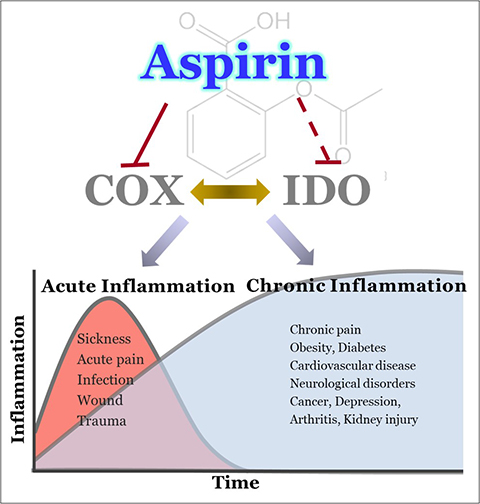New insights into an old drug: Scientists discover why aspirin works so well
New research has revealed important information about how aspirin works. Even though this drug has been available commercially since the late 1800s, scientists have not yet fully elucidated its detailed mechanism of action and cellular targets. The new findings could pave the way to safer aspirin alternatives and might also have implications for improving cancer immunotherapies.
Aspirin, which is a nonsteroidal anti-inflammatory drug, is one of the most widely used medications in the world. It is used to treat pain, fever and inflammation, and an estimated 29 million people in the U.S. take it daily to reduce the risk of cardiovascular diseases.

Scientists know that aspirin inhibits the cyclooxygenase enzyme, or COX, which creates messenger molecules that are crucial in the inflammatory response. Researchers led by Subhrangsu Mandal, a professor of chemistry and biochemistry at the University of Texas at Arlington, have discovered more about this process.
Prarthana Guha, a graduate student in Mandal’s lab, will present the team’s findings at Discover BMB, the annual meeting of the American Society for Biochemistry and Molecular Biology, March 25–28 in Seattle. Avisankar Chini also made significant contributions to the study.
“Aspirin is a magic drug, but long-term use of it can cause detrimental side effects such as internal bleeding and organ damage,” Mandal said. “It’s important that we understand how it works so we can develop safer drugs with fewer side effects.”
The team found that aspirin controls transcription factors required for cytokine expression during inflammation while also influencing many other inflammatory proteins and noncoding RNAs that are critically linked to inflammation and immune response. Mandal said this work has required a unique interdisciplinary team with expertise in inflammation signaling biology and organic chemistry.
They also showed that aspirin slows the breakdown of the amino acid tryptophan into its metabolite kynurenine by inhibiting associated enzymes called indoleamine dioxygenases, or IDOs. Tryptophan metabolism plays a central role in the inflammation and immune response.
“We found that aspirin downregulates IDO1 expression and associated kynurenine production during inflammation,” Mandal said. “Since aspirin is a COX inhibitor, this suggests potential interplay between COX and IDO1 during inflammation.”
IDO1 is an important target for immunotherapy, a type of cancer treatment that helps the body’s immune system seek out and destroy cancer cells. Because COX inhibitors modulate the COX–IDO1 axis during inflammation, the researchers predict that COX inhibitors might also be useful as drugs for immunotherapy.
Mandal and his team are now creating a series of small molecules that modulate COX–IDO1 and will explore their potential use as anti-inflammatory drugs and immunotherapeutic agents.
Prarthana Guha will present this research from 4–5:30 p.m. PDT on Tuesday, March 28, in Exhibit Hall 4AB of the Seattle Convention Center (Poster Board No. 185) (abstract). Contact the media team for more information or to obtain a free press pass to attend the meeting.
Enjoy reading ASBMB Today?
Become a member to receive the print edition monthly and the digital edition weekly.
Learn moreGet the latest from ASBMB Today
Enter your email address, and we’ll send you a weekly email with recent articles, interviews and more.
Latest in Science
Science highlights or most popular articles

From the journals: JLR
How lipogenesis works in liver steatosis. Removing protein aggregates from stressed cells. Linking plasma lipid profiles to cardiovascular health. Read about recent papers on these topics.

Small protein plays a big role in viral battles
Nef, an HIV accessory protein, manipulates protein expression in extracellular vesicles, leading to improved understanding of HIV-1 pathogenesis.

Genetics studies have a diversity problem that researchers struggle to fix
Researchers in South Carolina are trying to build a DNA database to better understand how genetics affects health risks. But they’re struggling to recruit enough Black participants.

Scientists identify new function of learning and memory gene common to all mammalian brain cells
Findings in mice may steer search for therapies to treat brain developmental disorders in children with SYNGAP1 gene mutations.

From the journals: JBC
Biased agonism of an immune receptor. A profile of missense mutations. Cartilage affects tissue aging. Read about these recent papers.

Cows offer clues to treat human infertility
Decoding the bovine reproductive cycle may help increase the success of human IVF treatments.

